Diversity
Our employee gender and female manager ratios for fiscal 2023 have received an independent third-party guarantee.
Basic concept
Tosoh believes that we must welcome and utilize a diversity of people and cultural values to continue to improve and generate corporate value. As such, the company is working to promote diversity. Our view is that increasing diversity internally will lead to improvement in our ability to respond flexibly and robustly to changes in the external environment, and to innovate.
Employee diversity in FY2023 (non-consolidated)
|
Age 0-17 |
Age 18-29 |
Age 30-39 |
Age 40-49 |
Age 50-59 |
Age 60 and above |
All |
| Male |
Female |
Male |
Female |
Male |
Female |
Male |
Female |
Male |
Female |
Male |
Female |
Male
subtotal |
Female
subtotal |
| Subtotal |
Subtotal |
Subtotal |
Subtotal |
Subtotal |
Subtotal |
Subtotal |
| Executive positions (career-track positions) |
0 |
0 |
0 |
0 |
35 |
1 |
400 |
11 |
511 |
4 |
5 |
0 |
951 |
16 |
| 0 |
0 |
36 |
411 |
515 |
5 |
967 |
| LeadershipSupervisors |
Career-track positions |
0 |
0 |
414 |
104 |
487 |
48 |
10 |
1 |
11 |
0 |
1 |
0 |
923 |
153 |
| 0 |
518 |
535 |
11 |
11 |
1 |
1,076 |
| General employees |
0 |
0 |
931 |
74 |
432 |
40 |
204 |
69 |
437 |
121 |
0 |
0 |
2,004 |
304 |
| 0 |
1,005 |
472 |
273 |
558 |
0 |
2,308 |
| Subtotal |
0 |
0 |
1,345 |
178 |
919 |
88 |
214 |
70 |
448 |
121 |
1 |
0 |
2,927 |
457 |
| 0 |
1,523 |
1,007 |
284 |
569 |
1 |
3,384 |
| Fixed-term employees |
0 |
0 |
9 |
6 |
12 |
5 |
11 |
3 |
21 |
12 |
266 |
24 |
319 |
50 |
| 0 |
15 |
17 |
14 |
33 |
290 |
369 |
| Total |
0 |
0 |
1,354 |
184 |
966 |
94 |
625 |
84 |
980 |
137 |
272 |
24 |
4,197 |
523 |
| 0 |
1,538 |
1,060 |
709 |
1,117 |
296 |
4,720 |
Structure and management
Under the Human Resources general manager, HR at headquarters and other locations work closely together to promote and develop human resources and labor policies.
Promotion of women in the workplace
Tosoh is committed to recruiting female employees, while promoting their success and retention. The cultivation of medium- to long-term female candidates for executive positions is a challenge we must overcome in the advancement of women. To this end, the company is increasing its number of female employees, by first establishing a recruitment target based on Japan’s Act on the Promotion of Women’s Participation and Advancement in the Workplace.
It is expanding the scope of activities of hired female employees by assigning them to manufacturing and sales departments—where they have traditionally not been posted—while considering their aptitudes and desired job types. The company is also working to retain female employees by providing career education to assist them in reviewing their careers and developing a vision of the future. Also, it is developing a work-life balance support system to eliminate departures from the workforce due to life events and to support female employees in achieving a favorable work-life balance.
Voice
Confidence in work generated through communication
When I was initially assigned, I was the first female employee at my workplace. As a result, my supervisor and senior staff members struggled to provide guidance and seemed reluctant for me to take on demanding tasks. While it was awkward on both sides, we continued to interact and hold discussions. Eventually, we came to understand each other better, and now they trust me with any job I want to do.
As a member of manufacturing staff, I work to improve profitability through capital investment and reduce operator workloads. The job requires that I work with my own department, suppliers, and other departments. I make sure to communicate my wishes and intentions so they don’t feel uncomfortable with me as a woman. I will continue to sharpen my communication skills, which are essential to my work, and to give all I can for my team. I hope that my achievements as a female employee in manufacturing will give confidence to women who work in this field in the future.
Ms. M
Cement & Energy Production Department
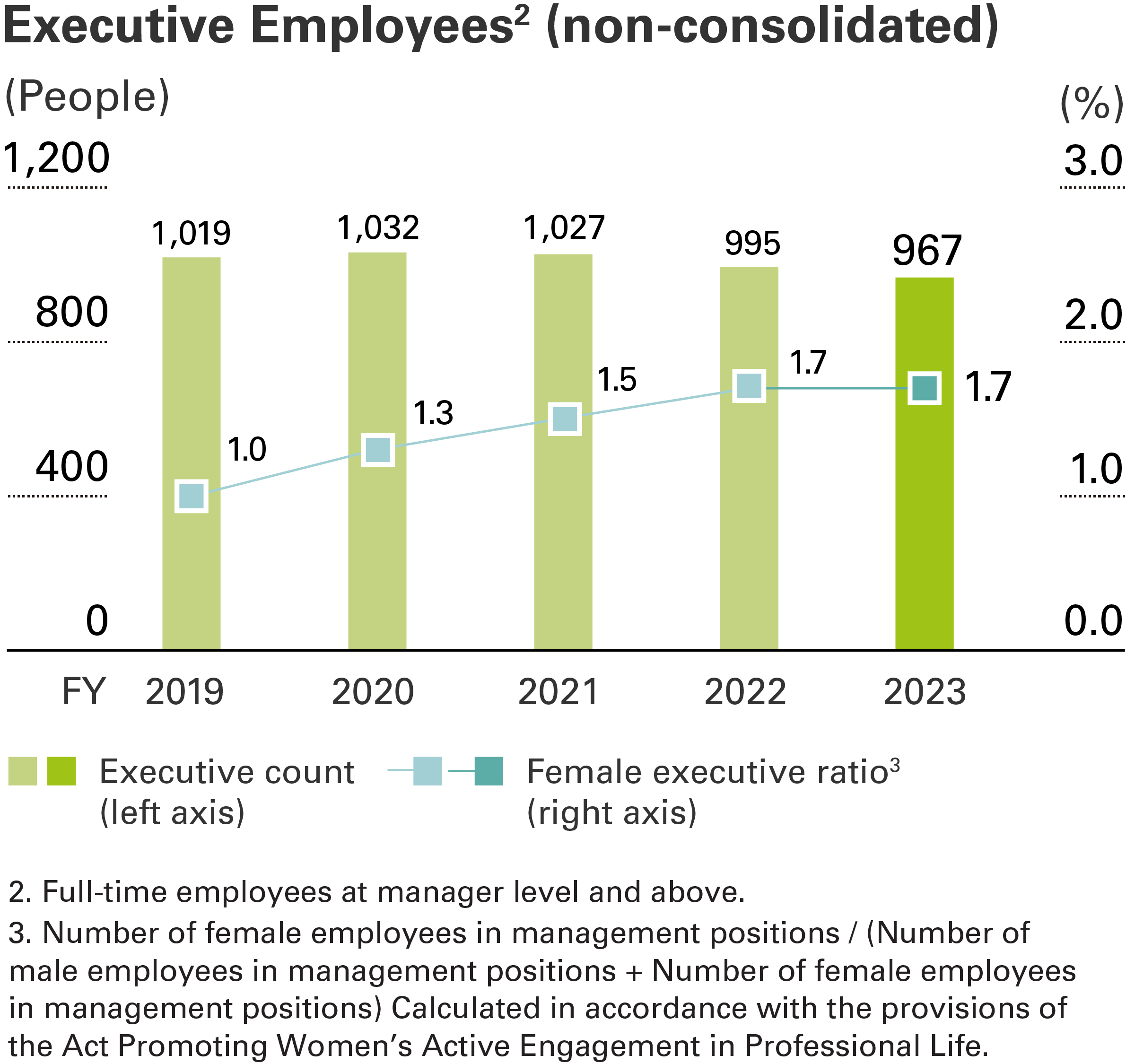
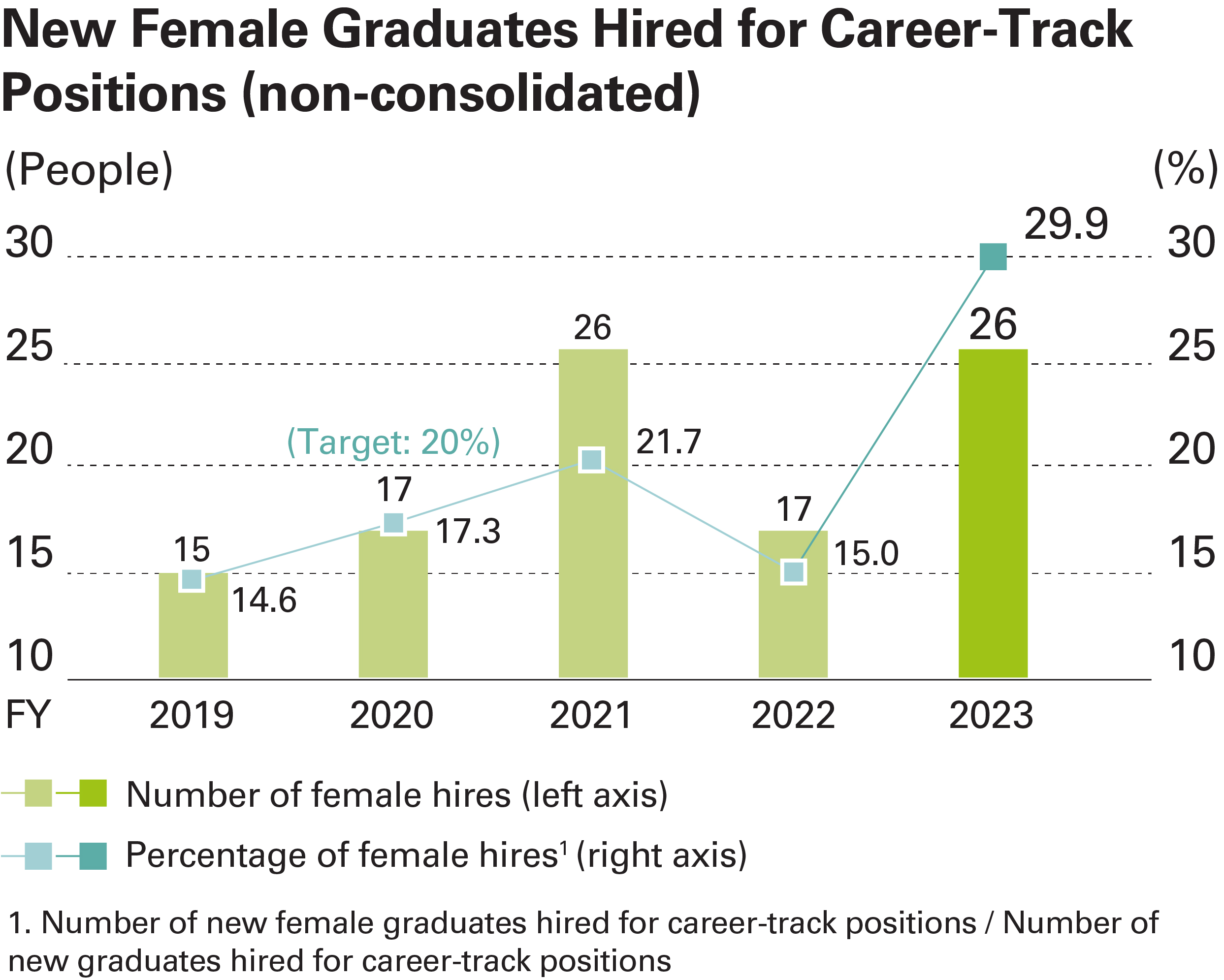
Promotion of senior human resources
Tosoh hires all mandatory retirees who wish to be rehired, and is implementing two initiatives for the purpose of encouraging these rehired employees to play active roles.
First, the company firmly communicates that the expectation for rehired employees is to use the knowledge, experience, and skills they have gained throughout their careers to maintain and boost corporate vitality and to strive to improve the company's overall skills and techniques by providing guidance and training to younger employees. Second, rehired employees and their supervisors meet twice a year for work interviews to clarify goals and foster a cooperative environment.
Moreover, from fiscal 2023, the company has started conducting training for people in their 50s to consider their future careers, helping them to envision their own post-retirement activities and creating awareness and plans in preparation for that part of their lives.
Promoting employment of people with disabilities
Tosoh employs individuals with various disabilities, including physical disabilities, as well as those with aural, visual, intellectual, and psychological impairments, regardless of severity. In order to ensure that everyone can thrive in their respective roles, we consider adjusting workload to account for medical appointments and health conditions and creating easy-to-understand work procedures.
Furthermore, we consolidate some administrative tasks and transfer them to employees with disabilities. These employees work in a satellite office with barrier-free facilities, receiving appropriate support to carry out their daily tasks. Additionally, as part of our employee welfare program, we distribute herbal tea and coffee produced through disability employment services. We view disability employment as a corporate social responsibility and will actively promote it while considering individuals' suitability for the job.
Foreign employees
As stated in the Tosoh Group Code of Conduct, we pay due respect to human rights, the prohibition of discrimination, and diversity, and hire with no distinction made on the basis of nationality, race, or ethnicity.
Work-life balance
Basic concept
The Tosoh Group believes that a company's greatest asset is its people, and that in order to sustainably create value, it is important to foster an open work environment that is rewarding to work in and recognizes and values human rights and diversity. Under the Tosoh Group CSR Basic Policy tenet, “Develop and promote a free and open corporate culture,” we are actively promoting the realization of work-life balance by creating a workplace environment that allows diverse human resources to balance work and family life and to continue working in a rewarding manner. We aim to realize an environment in which employees can continue to work with peace of mind, by providing and encouraging the use of work styles and various systems that suit their individual lifestyles.
Structure and responsible person
Under the supervision of the general manager of Human Resources, the Human Resources department at headquarters works closely with human resources at our complexes to promote and develop human resource and labor policies. We are proactive in information sharing and opinion exchange with human resources departments at group companies to promote efforts oriented toward improving the workplace environment and achieving a work-life balance across the breadth of the Tosoh Group.
Creating comfortable workplaces
Tosoh believes it is important to create an environment in which a diverse workforce can continue to work for many years with peace of mind. To this end, we are 1) promoting work style reforms to streamline operations and achieve work-life balance, 2) enhancing systems for balancing work and family life in support of employees' diverse circumstances, even when individual circumstances differ, and 3) promoting health management to aid employees in their own health development.
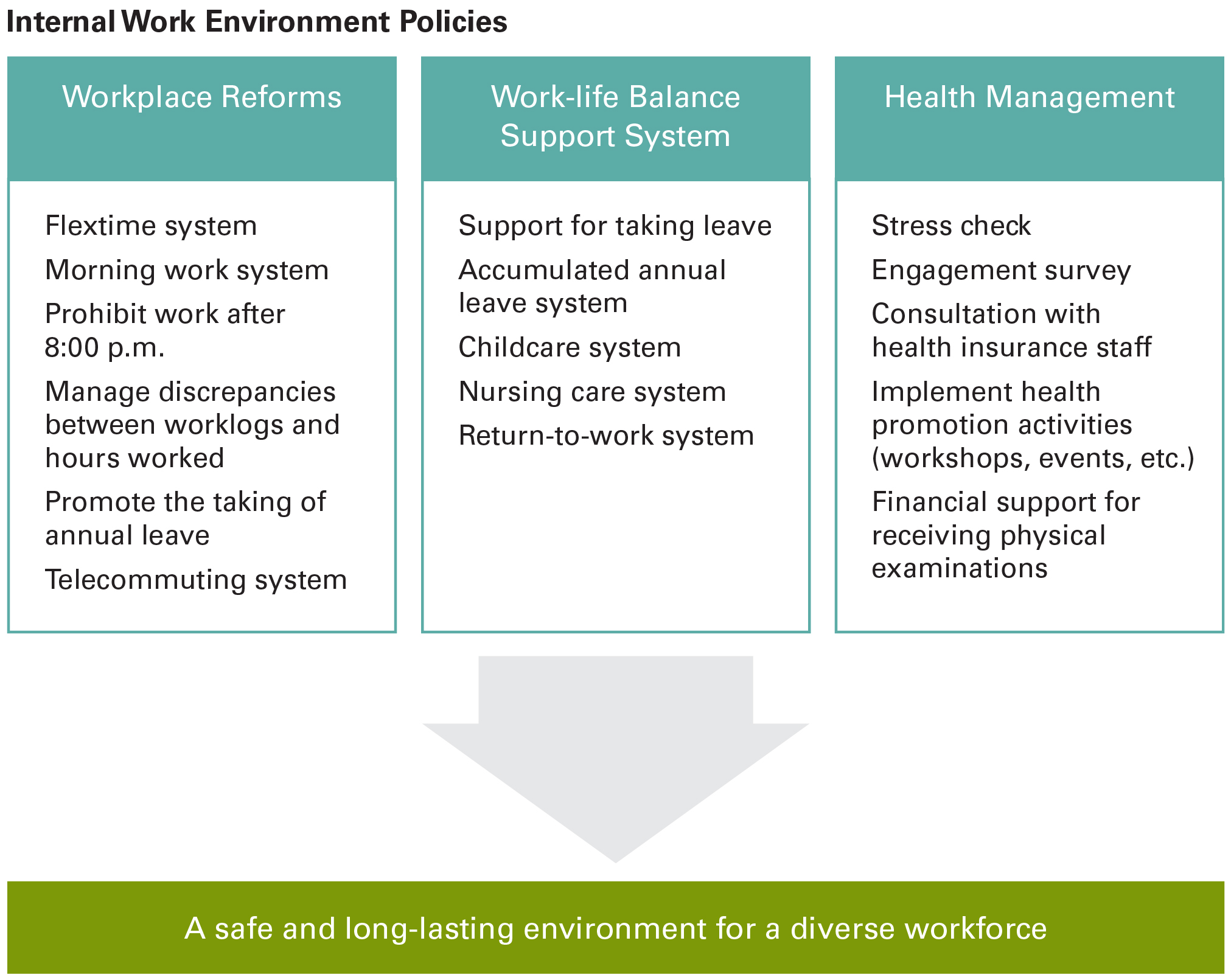
Work style reform
We are promoting work style reforms with the aim of enhancing corporate competitiveness. Our efforts to curb long working hours and boost productivity have enhanced both employee job satisfaction and comfort while at the same time building a strong corporate culture.
Specifically, we are working on various measures to foster time awareness, enhance systems for creating a comfortable work environment, and promote operational efficiency throughout the company and in each workplace.
Work style reforms undertaken (Tosoh non-consolidated)
| Key activities |
Purpose |
Overview |
Morning-oriented
work |
Curb long working hours and foster a sense of time awareness |
Prohibit working after 8:00 p.m. in principle, so as to rethink the way of working, shifting from night work to morning work |
| Flex-time system |
Promote flexible work schedules |
Eliminate core hours, enabling a better work-life balance |
Systematize work time
management |
Appropriate working hour management |
Systematize time and attendance management
Check deviations from work applications by acquiring PC log information to promote proper attendance management |
Reform web
conferencing system |
Leverage IT to improve operational efficiency |
Promote further use of online conferencing by equipping workplaces and meeting rooms at each complex with the necessary equipment for web conferencing |
Workplace discussions
on operational efficiency |
Workplace-specific operational efficiency |
Create opportunities for each workplace to discuss issues and solutions in the workplace, and implement and promote measures to improve operational efficiency |
| Remote work system |
Increased labor productivity |
Expand telecommuting system for remote work while maintaining internal communication (twice a week and up to six times a month) |
| Promotion of flexible work system |
No restrictions on reasons such as childcare or nursing care; available to employees who are eligible for the flex-time system and who have been approved by their department manager and the company |
Curbing long working hours
With the aim of curbing long working hours from the viewpoint of overwork prevention and health management, Tosoh in principle prohibits employees from working after 8:00 p.m. If there are situations in which working past this time is unavoidable, we will review the work style with consideration for early morning starts. This is intended to reduce after-hours work, which contributes to long working hours, improve productivity by fostering a sense of time awareness, and realize a better balance between work and life away from the job by encouraging employees to return home early.
Moreover, we are confirming discrepancies between the actual log-on/log-off times of computers and employees’ work attendance applications using the working hour management system. Employees with discrepancies in excess of 20 hours per month are required to submit written justification, which leads to reduced working hours and the optimization of work attendance applications. All employees who work in excess of 80 hours of overtime per month are required to be interviewed by an occupational physician regardless of the nature of their request.
Through these interviews, we are attempting to prevent physical and mental health problems among employees.
Working hours per employee* (Tosoh non-consolidated)
|
Fiscal 2021 |
Fiscal 2022 |
Fiscal 2023 |
| Overtime hours/month |
16.2 |
16.4 |
16.3 |
| Total actual working hours/year |
1910.1 |
1887.9 |
1869.9 |
* Data on Supervisory and Responsible Positions
Improvement of annual paid leave utilization rate
Tosoh believes that taking annual paid leave helps employees refresh their minds and bodies through a more balanced work style, and that this in turn contributes to increased productivity. We have set a company-wide annual leave utilization rate target of at least 80 percent. Our efforts to improve the rate enabled us to achieve the target in fiscal 2023. We are focusing particularly on creating a workplace environment in which annual leave is easy to take. In addition to educational activities through a host of training programs, we share the dates when annual leave is due to be taken using a scheduler in each workplace, thereby visualizing the status of annual leave usage.
Paid annual leave taken (Tosoh non-consolildated)
|
Breakdown |
Fiscal 2021 |
Fiscal 2022 |
Fiscal 2023 |
| Days acquired (per person) |
Executives |
12.2 |
13.1 |
13.7 |
| Nonexecutives |
15.9 |
16.4 |
17.2 |
| Average |
15.2 |
15.8 |
16.6 |
| Utilization rate (%) |
Executives |
61.5 |
65.6 |
68.7 |
| Nonexecutives |
83.5 |
86.3 |
88.6 |
| Average |
79.2 |
82.4 |
85 |
Note: The aggregation period is from July of the current year to June of the following year.
Improved operational efficiency
Tosoh considers the improvement of operational efficiency to be a key initiative in creating a comfortable workplace. To this point, we have endeavored on a company-wide scale to improve productivity by reducing the use of paper and utilizing IT.
| Paper elimination initiatives |
IT utilization initiatives |
- Changing the workflow for various application procedures
- Changing the workflow for approval procedures
- Reducing internal documents
- Providing support for automated faxing of order confirmations, etc.
|
- Computer remote operation systems
- Expanding work management systems
- Introducing electronic lab notebooks
- Introducing tablets in the Facility Management department
- Introducing cloud storage
- Introducing hot desking and other systems
|
Each workplace also reviews its own operations and offers encouragement in the form of improvement proposals as a measure to incentivize employees to improve operational efficiency. By encouraging employee creativity and ingenuity, promoting active participation in work, and developing new skills and honing existing ones, we create comfortable workplaces and a resilient corporate structure, leading to the further development of the company.
In addition to the “Working Style Reform Award” and “Work and Office Work Improvement Award,” which are aimed at improving operations that lead to work style reform, we have also established a “Group Award” and “Energy Saving Proposal Award” aimed at reducing CO₂ emissions to encourage improvement proposal activities. Tosoh's wholly-owned domestic group companies are also engaged in improvement proposals to further invigorate the Group overall.
Improvement proposals (Tosoh non-consolidated)
|
Fiscal 2021 |
Fiscal 2022 |
Fiscal 2023 |
| No. of proposals |
11,485 |
10,581 |
14,550 |
Support system for balancing work and home life
In the interest of actively supporting diverse human resources in balancing work and family life, we aim to realize an environment in which employees can continue to work with peace of mind, by providing and encouraging the use of work styles and various systems that suit their individual lifestyles.
Childbirth and childcare systems
At Tosoh, we believe that enjoying child-rearing leads to personal growth for our employees in all aspects of their lives, including work. To this end, it is also important to create an atmosphere in which the entire workplace—including supervisors—understands and is comfortable with systems related to childbirth and childcare.
We have developed and posted on the intranet a publication outlining the systems related to pregnancy, childbirth, and childcare for employees to review. The publication also includes a section specifically for supervisors, clearly stating what they should keep in mind and a checklist to encourage them to communicate appropriately on the subject. We open lines of communication between employees and superiors to ensure all employees who wish to take childcare leave are able to do so smoothly and to reduce anxiety upon returning to work.
We also believe that increasing the number of male employees taking childcare leave will positively impact the creation of comfortable workplaces. As a result of our establishment of a goal to boost the utilization rate, we have seen it increase each year, surpassing 40 percent for the first time in fiscal 2022. In fiscal 2023, we achieved 85.5 percent of employees taking childcare leave, far exceeding the 50 percent target, with an increase in the average number of days taken. In fiscal 2024, we will raise the target rate to at least 90 percent and continue encouraging male employees to be involved in childcare.
Moreover, employees who take and complete correspondence courses during childcare leave will receive an independent study allowance from Tosoh to cover all course costs and help them return to work smoothly.
Voice
After taking childcare leave
I took childcare leave for two and a half months after the birth of my first son and devoted myself to taking care of him. My wife had returned to her hometown to give birth to my first daughter, so this was the first time for me to take care of a newborn, even though it was my second child. It had been almost two years since I had cared for a baby. Although there were many things that had me at a loss, I was able to get an up-close-and-personal view of my son changing and growing every day.
There were times when I felt the mental hardship and adversity of childcare, like when I was carrying my son, feeding him, and putting him to bed while dealing with my eldest daughter. Still, it was really great to take childcare leave because it allowed me to spend this unique time in my family of four.
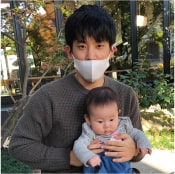
Childcare data (Tosoh Corporation employees)
|
Male/Female |
FY2021 |
FY2022 |
FY2023 |
| Childcare leave recipients |
Male |
63 |
72 |
141 |
| Female |
18 |
13 |
19 |
| Total |
81 |
85 |
160 |
| Childcare leave acquisition rate2 (%) |
Male |
35.2 |
40.4 |
85.5 |
| Female |
100 |
100 |
100 |
| Return rate3 (%) |
Male |
100 |
100 |
100 |
| Female |
88.2 |
100 |
93.3 |
| Retention rate of returnees4 (%) |
Male |
100 |
100 |
100 |
| Female |
100 |
100 |
100 |
| Male employees childcare/paternity leave recipients |
|
171 |
174 |
161 |
| Male employees childcare/paternity leave acquisition rate5 (%) |
|
95.5 |
97.8 |
97.6 |
| Employees taking advantage of reduced working hours to facilitate child care |
Male |
0 |
1 |
3 |
| Female |
38 |
49 |
39 |
| Total |
38 |
50 |
42 |
1. Includes employees seconded to Group companies.
2. Number of employees who took childcare leave/number of employees who welcomed a new child.
3. Number of employees who returned to work/number of employees who were scheduled to return.
4. Retention rate of employees 12 months after returning to work/number of employees who returned to work in the previous fiscal year.
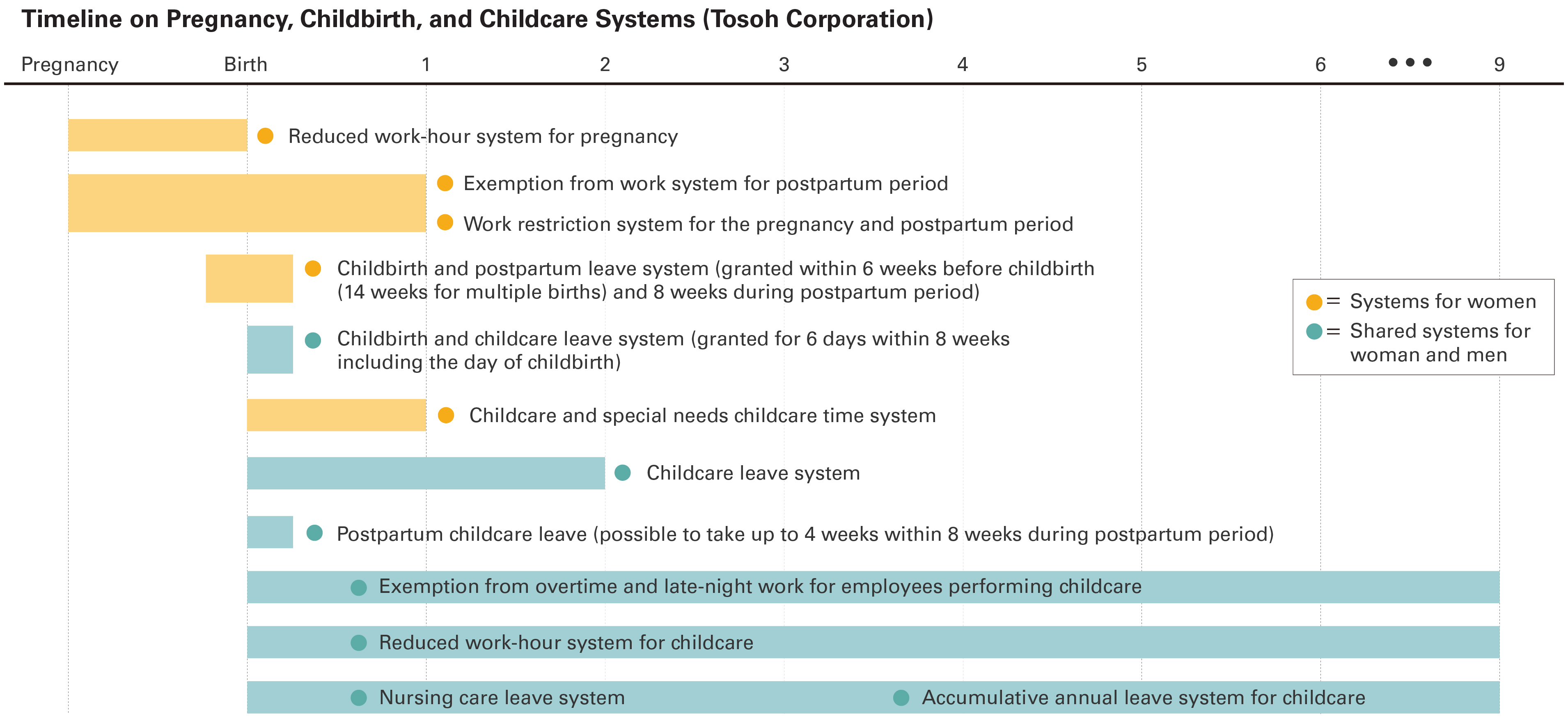
Support system for balancing work and childbirth/childcare (Tosoh non-consolidated)
| Work-related systems |
Work exemption for safe motherhood |
Exemption from working the required number of days and hours for reasons such as health guidance, medical examinations, and doctor’s orders |
| Limited work for expectant mothers |
Restrictions on working overtime, on days off, and night shifts |
| Parental leave before and after childbirth |
Female employees within six weeks before childbirth (or 14 weeks for multiple births) and eight weeks after childbirth (treated as paid) |
| Maternity leave |
Up to six days within eight weeks of the child’s birth (treated as paid, may be split over two uses) |
| Childcare leave |
Until the child is two years old (first seven days treated as paid leave) |
| Postnatal childcare leave |
Up to four weeks within eight weeks of birth (may be split over two uses) |
| Reduced working hours |
Up to two hours per day during pregnancy and through the end of the child’s third year of elementary school |
| Leave to care for ill/injured child |
Leave can be taken from five-minute increments when caring for a child (treated as paid leave)
One child: Five days (40 hours) per year
Two or more children: 10 days (80 hours) per year |
| Using accumulated annual leave to care for sick/injured children |
May use accumulated annual leave to care for a sick/injured child up to the third year of elementary school |
| Using accumulated annual leave to receive fertility treatments |
May use accumulated annual leave for fertility treatments |
| Benefit programs |
Gift to celebrate birth |
Paid upon childbirth |
| Assistance for hospitalization expenses |
Subsidy for expenses when an employee or spouse is hospitalized for procedures such as Cesarean section |
| Assistance for room upgrade |
Assistance to cover out-of-pocket expenses for upgrading beds when employees or their spouses are hospitalized for Caesarian sections or other procedures |
| Family allowance |
Monthly allowance based on number of dependents and children |
Nursing care-related systems
In recent years, the number of people who have had to leave their jobs to care for family members has been on the rise in Japan. At some point, everyone faces the possibility of nursing care. That is why it is essential to create an environment in which employees can continue to work with peace of mind, and to create a culture in which the entire workplace understands and cooperates with each other to prevent employees from leaving the workforce to provide nursing care. Tosoh has published a nursing care guidebook to provide enhanced information for employees who care for family members while working and their colleagues in the workplace. It is more challenging for companies to ascertain the needs of their employees to provide nursing care than it is for childcare. As such, in 2022, we conducted a survey of all employees regarding nursing care. The results showed us that more than half of our employees may need to take care of a family member in the future. We will use the survey results to further enhance the system to allow employees to continue their work with peace of mind.
Nursing care-related data (Tosoh Corporation employees)
|
Fiscal 2021 |
Fiscal 2022 |
Fiscal 2023 |
| Nursing care non-paid leave recipients |
0 |
0 |
1 |
| Nursing care paid leave recipients |
14 |
15 |
33 |
| Employees who work reduced hours due to nursing care |
0 |
0 |
0 |
Support System for Balancing Work and Nursing Care (Tosoh non-consolidated)
| Work-related systems |
Nursing care non-paid leave |
Up to 1 year (may be split over a maximum of three installments) |
| Nursing care paid leave |
When taking care of a family member, leave may be taken in increments of five minutes (treated as paid leave)
One family member requiring care: Five days (40 hours) per year
Two or more family members requiring care: 10 days (80 hours) per year |
| Reduced working hours |
Up to two hours per day for a total of 1,096 days (three years) |
| Using accumulated annual leave to care for family members |
When taking care of a family member, accumulated annual leave may be taken in half-day increments (treated as paid leave) |
| Benefit programs |
Separation allowance |
Monthly stipend to help compensate employees who live separately from their spouse to care for family members |
| Subsidy to cover the cost of caregivers |
Assistance provided when an employee or family member hires a housekeeper for care needs |
Other welfare programs
Tosoh has established numerous benefit programs designed to support the livelihood of its employees, help them to build assets, and support them in realizing a better work-life balance.
| Program name |
Details |
| Refreshment support leave |
Encourages employees to take at least five consecutive days of annual leave each year |
| Active leave |
At the age of 50, employees receive 10 consecutive days of leave and a travel voucher worth 300,000 yen |
| Restart leave |
Up to seven consecutive days of leave within one month of reemployment |
| Using accumulated annual leave for volunteer activities |
Employees can use accumulated annual leave to participate in volunteer activities, including disaster recovery assistance and social welfare |
| Reemployment system |
Support for returning to work for employees who resigned due to marriage, spouse relocation, childcare, or nursing care |
| Company housing and dormitories for single employees |
Company housing and dormitories for single employees are provided at each complex |
| Personal housing allowance |
Financial assistance for employees who acquire their own housing |
| Rental housing allowance |
Financial assistance for employees who live in rental housing |
| Workplace social gathering expenses |
Company subsidies for workplace social gatherings and events |
| Shareholding association |
Facilitation of employees' acquisition of company stock and support for building of assets |
| Hospitalization expense assistance |
Assistance with hospitalization expenses when an employee or spouse is hospitalized |
Health management
Tosoh recognizes that the physical and mental health of its employees is the foundation for realizing its corporate philosophy and the Tosoh Group CSR Basic Policy. We are therefore actively undertaking health promotion activities so that our employees can realize their full potential.
Health declaration
Tosoh believes that the realization of our corporate philosophy is predicated upon the physical and mental health of our employees. As such, we actively work to maintain and improve their health and create comfortable work environments.
Health promotion activity policy
1. Continuously strive to maintain and improve the physical and mental health of our employees.
2. Focus on activities from the perspectives of prevention and early detection.
3. Aim to create a cheerful and energized workplace where all employees of Tosoh and the Tosoh Group are healthy people.
Promotional structure
To implement the Health Declaration, we have established a Health Promotion Committee chaired by a director involved in Human Resources to work on maintaining and promoting the health of our employees. Human Resources is responsible for implementing health promotion activities at each complex. The Tosoh Labor Union shares information on health issues between labor and management. The Tosoh Health Insurance Association is involved in finances for health activities, while the Health Management Center is staffed by specialists such as occupational physicians, public health nurses, and nurses. Together, they work to carry out various health promotion activities.
The Health Promotion Committee meets twice annually to establish numerical health promotion targets, manage progress, and report the results of initiatives at our complexes.
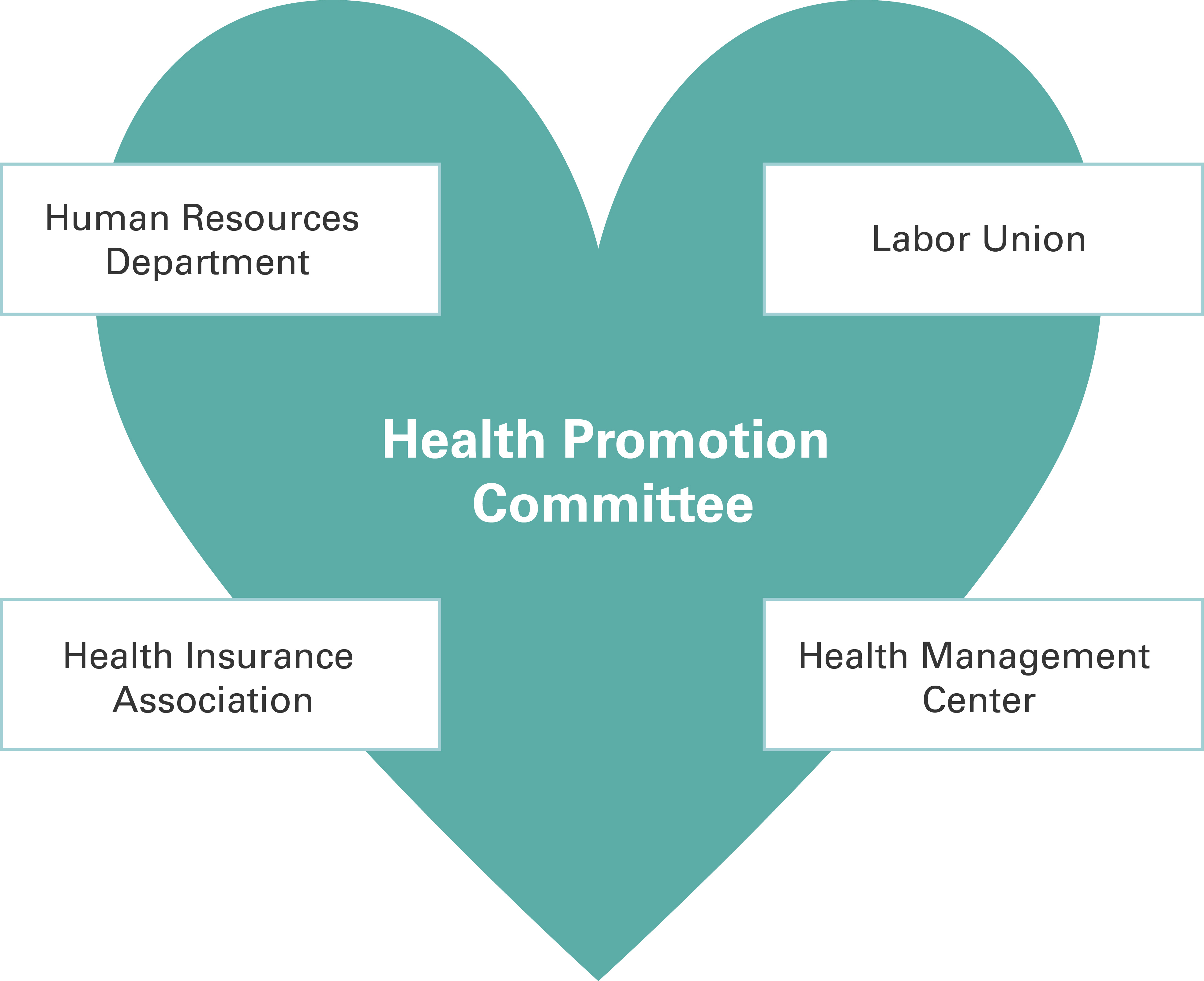
Health promotion initiatives
To support the physical and mental health of our employees, each complex plans and operates its own activities each year with unique ideas and approaches in addition to company-wide health promotion activities based on the three pillars of physical fitness, lifestyle improvement, and mental health.
Moreover, we have set company-wide numerical targets with fiscal 2025 as the year by which we will establish a system to implement the PDCA cycle for the purpose of further promoting health management. To achieve these targets, we will support good health through health promotion activities, and maintain and promote a comfortable work environment.
Health promotion activities
|
Activities |
Notes |
| Physical fitness |
Company-wide walking event |
Twice a year, for 3 months each, participatory events with the goal of walking 8,000 steps per day |
| Walking events at complexes |
Walks meant to encourage friendship as part of all locations’ recreation events |
| Physical fitness test |
Measure 6 items, including muscle strength, agility, and cardiopulmonary endurance, with the overall evaluation expressed as a “physical fitness age.” Conducted every 5 years to provide an opportunity to review employee physical fitness |
| Lifestyle improvement |
Birth month health counseling |
Employees can discuss lifestyle and mental health issues with occupational physicians, public health nurses, and registered nurses, while referring to data such as physical examination results |
| Smoking cessation activities |
Provides information on smoking cessation, offers financial support to those who wish to quit smoking |
| Mental health |
Mental health education |
Conducted training on basic knowledge of mental health for general employees
Conducted training held for executive personnel on workplace and individual mental health |
Health promotion activity numerical targets (Tosoh Corporation employees)
| (%) |
Fiscal 2022 results |
Fiscal 2023 results |
Fiscal 2025 targets |
| Physical |
BMI ≧ 25 (obesity rate) |
20.2 |
20.8 |
18.5 or less |
| Physical |
Smoking rate |
17.5 |
17.2 |
14.5 or less |
| Mental |
People under extreme stress (conventional standard) |
3.8 |
- |
3.0 or less |
| Mental |
People under extreme stress (new standard) |
- |
6.0 |
4.5 or less |
Note: With the update of the survey company's criteria for determining high-stress individuals, the target value has been changed from the same level of 3.0% or below to 4.5% or below.
Periodic health examinations
All employees of the Tosoh Group are covered by health insurance under the Health Insurance Act. In accordance with the Industrial Safety and Health Act, we conduct periodic health examinations, and we have succeeded in ensuring physical examinations every year for 100 percent of our employees. In addition to general periodic checkups, we also provide lifestyle-related disease examinations, while colon, stomach, prostate cancer, and dental checkups are available for those who wish to receive them. In the regular health check-ups for the fiscal year 2023, the rate of employees who discovered a condition that required further investigation was 43.1% among all examinees, showing an improvement of 1.1 percentage points from the previous year. For employees identified with these findings, the results of the re-examination are submitted to the company doctor, contributing to the subsequent health management of the employees.
Moreover, we conduct specific medical examinations for employees aged 40 and over to prevent serious complications from lifestyle-related diseases—such as heart disease and stroke—caused by metabolic syndrome.
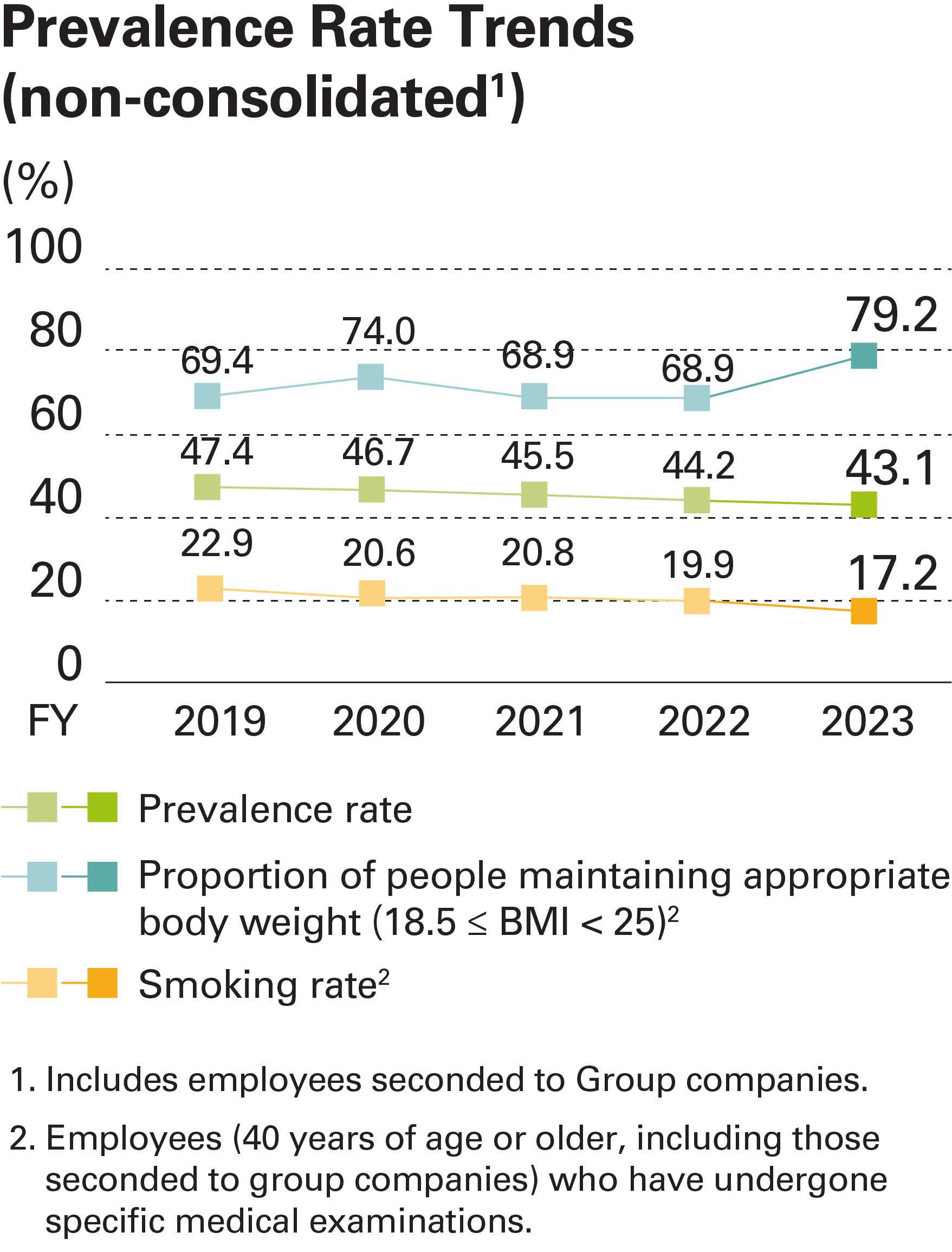
Subsidized health examinations (Tosoh non-consolidated)
| Individual/Group |
Name |
Eligibility |
How to get examinations |
Out-of-pocket expenses |
Examination restrictions |
| Individual |
Complete physical examination |
Insured employees and their dependent spouses |
Employees visit the institution of their choice |
10% for one-day/20% for overnight checkups (with a maximum insurance coverage of ¥100,000) |
Once per fiscal year per item |
| Gynecological checkup |
10% as a general rule (with a maximum insurance coverage of ¥20,000) |
Once per fiscal year per item |
| Dental checkup (oral examinations) |
Insured employees and their dependents (excluding preschool–high school students) |
Amount exceeding ¥3,000 (maximum insurance coverage of ¥3,000) |
Once per fiscal year |
| Influenza vaccination |
Insured employees and their dependents |
¥1,000 per vaccination |
Once per designated period (as a general rule)
(twice for infants) |
| Treatment for smoking cessation |
Insured employees |
Same amount as when covered by insurance
(assistance for 70% of the cost) |
Once per fiscal year |
| Specific medical checkups |
Dependents 40 years old and older |
Free (using a medical examination voucher) |
| Group |
Blood tests |
Insured employees (if desired) |
Group examinations by complex |
Free |
| Dental checkup (oral examinations) |
| Colorectal examinations |
| Gastric examinations (barium and fluoroscopy) |
| Cancer markers |
A portion of the complete medical checkup (10% out-of-pocket) |
Stress test engagement survey
Stress tests and engagement surveys are conducted once each year. Stress checks are used as mental health examinations, leading to the identification of issues in the workplace as well as early detection and response to problems, by understanding the mental health condition of employees.
The examination rate in fiscal 2023 was 97.3 percent, and the share of people deemed to be under extreme stress was 6.0 percent. Tosoh saw an increase in the proportion of individuals under high stress compared with the preceding fiscal year, despite the figure remaining lower than the average of companies found by an external survey. In addition to working to reduce stress by encouraging employees with high levels and recommending the use of counseling, the results of workplace analysis are fed back to the heads of each department for organizational management purposes.
The engagement survey also confirms employees’ work ethic, as we believe that satisfaction with the company and enthusiasm for work are important for employees to maximize their potential. The results of the survey will be used to develop HR policies and initiatives to improve productivity, with the aim of further improving engagement and invigorating the organization.
Engagement survey results
| Favorable elements |
Problematic elements |
- Worker autonomy
- Perceived fit with the Company
- Satisfaction with evaluations
|
- Demonstrating strengths
- Confidence in one’s work
|
Support program for employees returning from mental health leave
Tosoh has established a return-to-work support program for employees who have been absent from work due to mental health issues. We collaborate with occupational physicians and the Tosoh Labor Union during each step of the process, from the identification of the illness until after the employee returns to work, to help alleviate employee anxiety and facilitate a smooth return.
- Step 1: Identifying and responding to disorder
- Step 2: Submission of medical certificate (in event of inability to work)
- Step 3: Care during absence from work
- Step 4: Declaration of intent to return (determination of suitability for return by the attending physician)
- Step 5: Examination by occupational physician
- Step 6: Assistance in visualizing return to work
- Step 7: Decision on whether or not to reinstate the employee at a meeting of the Reinstatement Review Committee
- Step 8: Building structure for cooperation following return to work
- Step 9: Follow-up after return to work
Human resources system
Tosoh's basic philosophy for its personnel system is rooted in these three pillars: a creative organization that allows employees to maximize their capabilities, a challenging culture employing a point-based system for thorough evaluations, and fair treatment whereby those who work hard are truly rewarded. We aim to establish a systemic foundation that rewards those who act with a sense of ownership. With the aim of promoting employee skill and human resources development, we organically link four individual systems: the job classification system, the training interview system, the personnel evaluation system, and the wage system.
Basic philosophy of human resources system
- Creative organization that allows employees to maximize their capabilities
- Challenging culture employing a point-based system for thorough evaluations
- Fair treatment whereby those who work hard are truly rewarded
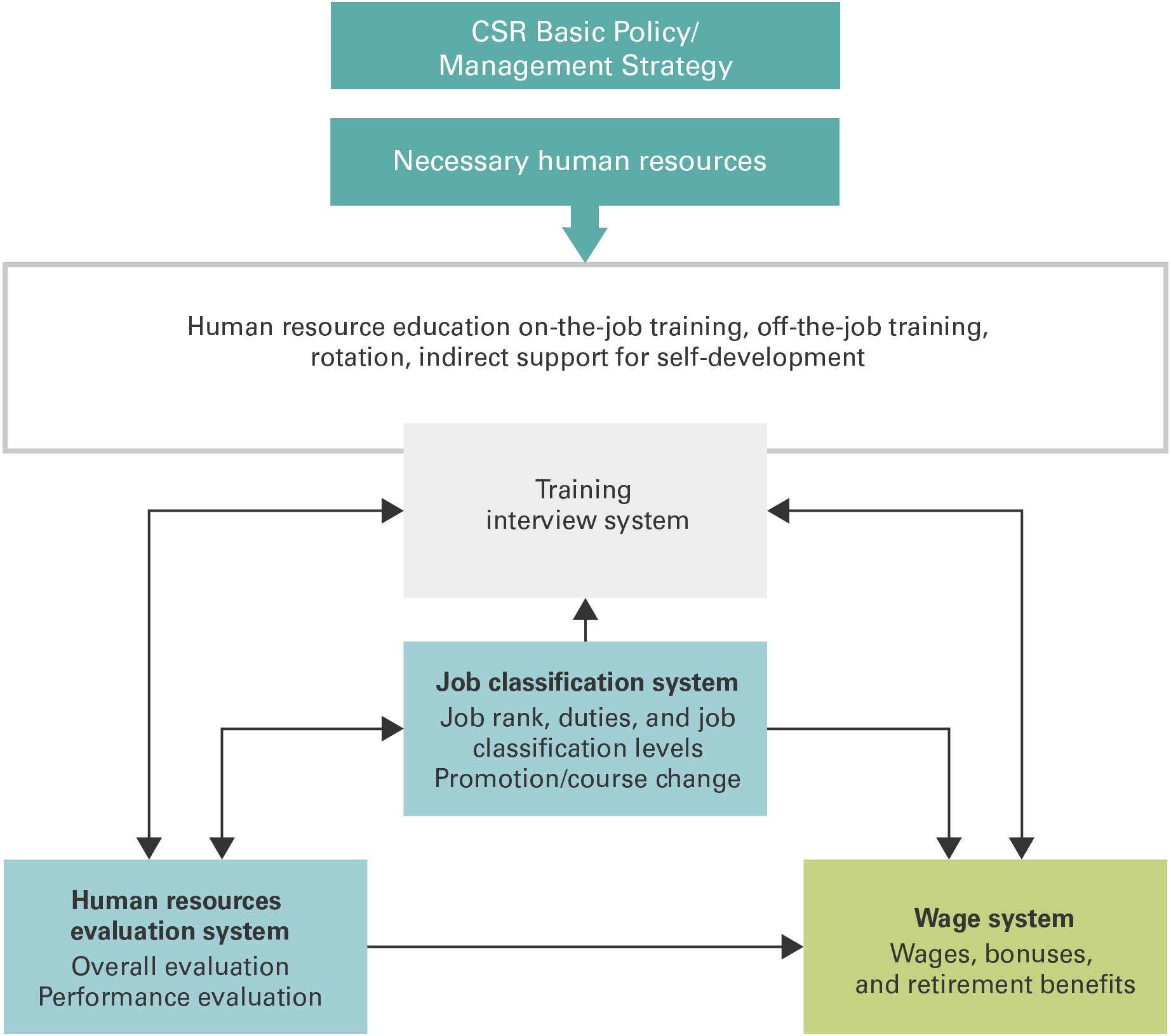
Employee evaluation and feedback
Tosoh organizes the job performance capabilities of its employees into job levels, job classifications, and career tracks. These help to clarify the requirements for each individual. This includes the role to be fulfilled and an image of the future as an objective, and serves as a set of guidelines for skill development and training objectives. Employees set annual work goals, short- and long-term career plans, and the skills they wish to acquire as they consider their own careers. Through these training interviews, employees and their supervisors mutually confirm the degree of progress and achievement of work goals, ability to perform duties over the short and long term, aptitude, and diagnosis and declaration of career development, while encouraging individual job development in addition to improving the employee's ability and motivation. Based on the results of the training interview, supervisors evaluate the employees in biannual personnel evaluations.
In addition, the main objective of personnel evaluation is “human resource development,” and effective skill development is achieved by providing feedback from supervisors on employees' strengths and weaknesses at training interviews, as well as guidance and advice regarding the execution of work objectives. Career tracks include comprehensive positions for employees who wish to develop their careers in a wide range of fields, with general positions for those who are seasoned experts. Employees in general positions who have been assessed as having the ability to perform duties suitable for career-track positions are converted to these through course change.
Wages and compensation
Tosoh discloses its salary and wage systems to employees. The salary structure is divided by job level, job classification, and job performance course, with the same structure applied to both men and women. Bonuses are determined through discussions between labor and management. The company has introduced a performance-based compensation system to increase transparency in the process of determining the amount to be paid and to boost employee satisfaction.
Starting wages in fiscal 2023 (Tosoh non-consolidated)
|
Monthly salary (JPY) |
Comparison with minimum wage* (%) |
| High school |
189,137 |
114.9 |
| Junior college |
193,033 |
117.3 |
| Technical college |
211,111 |
128.2 |
| University |
231,146 |
140.4 |
| Graduate school (Master’s degree) |
248,501 |
151.0 |
Note: Calculated based on 1,072 yen per hour, the minimum wage in Tokyo, for a monthly work schedule of 20.25 days per month and 7 hours and 35 minutes per day.
Employee male/female wage ratio1 in fiscal 2023 (Tosoh Corporation employees)
|
Gender wage ratio2 (%) |
| Full-time employees |
73.5 |
| Fixed-term employees |
70.6 |
| Overall |
72.6 |
- Calculated in accordance with the provisions of the Act Promoting Women’s Active Participation in the Workforce.
- Average annual salary for women/men. The same wage system applies regardless of gender. Differences depend on job performance.
Related Page: Respect for human rights/control of wages
Labor-management relations
Tosoh Corporation and the Tosoh Labor Union have concluded a collective agreement in the spirit of Japan’s Labor Union Act and Labor Standards Act. The two sides are bound to respect the other’s position, deepen understanding and trust between them, and confirm their mutual cooperation to contribute to the development of the company's business and the improvement of conditions for employees. The collective agreement includes the following matters: Labor-management committee, collective bargaining, human resources, working hours, days off and paid holidays, salaries, health and safety, welfare, accident compensation and assistance for work-related illness and injury, harassment, and education. Tosoh acts as a union-organized shop, and all employees are members of the Tosoh Labor Union, excluding certain staff in executive positions and those involved in management-related work.
The Tosoh Labor Union represents its members in labor-management negotiations, and through committees and councils conducted based on specific themes has built good, stable labor-management relations with a sense of trust for discussions that can be tense. The two sides will continue to communicate closely to respect each other's position and cooperate in the interest of contributing to the development of the company's business and the improvement of conditions for employees.
Tosoh Labor Union composition
|
Fiscal 2021 |
Fiscal 2022 |
Fiscal 2023 |
| No. of union members1 |
3,258 |
3,346 |
3,367 |
| Union membership ratio2 (%) |
70.4 |
71.8 |
70.5 |
| No. of union representatives3 |
6 |
6 |
6 |
- Number of employees (including those seconded to group companies), excluding executives and certain staff involved in management-related work.
- Number of members/employees
- Representatives elected by union members
Labor-management communication
The Central Management Council meets once a month to discuss the company's management situation, human resource systems, improvement of working conditions, and other issues with the aim of achieving a common understanding of the current situation and challenges. The discussions are disclosed in the form of minutes on the company intranet and are accessible to all employees. Tosoh Corporation provides advance notice to the Tosoh Labor Union and employees when implementing major changes in business operations that may significantly impact employees.
Additionally, all workplaces hold Health and Safety Committee meetings once per month to hear health and safety-related opinions from the Tosoh Labor Union and employees and to deliberate on measures to be taken.
Key content of the 2023 Central Management Council Meeting
- Explanation of management situation
- Recruitment plan
- Promoting the use of annual and childcare leave and related programs
- Safety and disaster prevention/occupational safety and health
- Measures to prevent excessive working hours
- Wage hikes and bonuses
- Revision of reemployment system
- Revision of leave system
- Reports, requests, etc. from labor union
History of system revisions through labor-management discussions
| Fiscal year |
Revisions |
| 2021 |
- Revised the paid leave rules and family allowance payment rules
- Introduced a reemployment system
- Introduced a remote work system
|
| 2022 |
- Partially revised the paid leave rules
- Expanded the remote work system
|
| 2023 |
- Revised the childcare leave rules
- Revised the childcare and nursing care leave rules
- Revised the rules on dual/secondary employment
|
Human Resources Development
Basic concept
Based on our philosophy that “education is for developing the type of human resources envisioned by management, contributing to the self-realization of employees in the process,” Tosoh has systematically established various educational and training programs to help employees fully develop their personal potential and qualities, cultivate the ability to think independently, and acquire knowledge and skills related to safe and stable operations.
In fiscal 2022, the company formulated a new basic policy for human resources development. Tosoh believes that the growth of the company is led by the self-reliant growth of its employees, and as such aims to develop human resources who can think and act on their own.
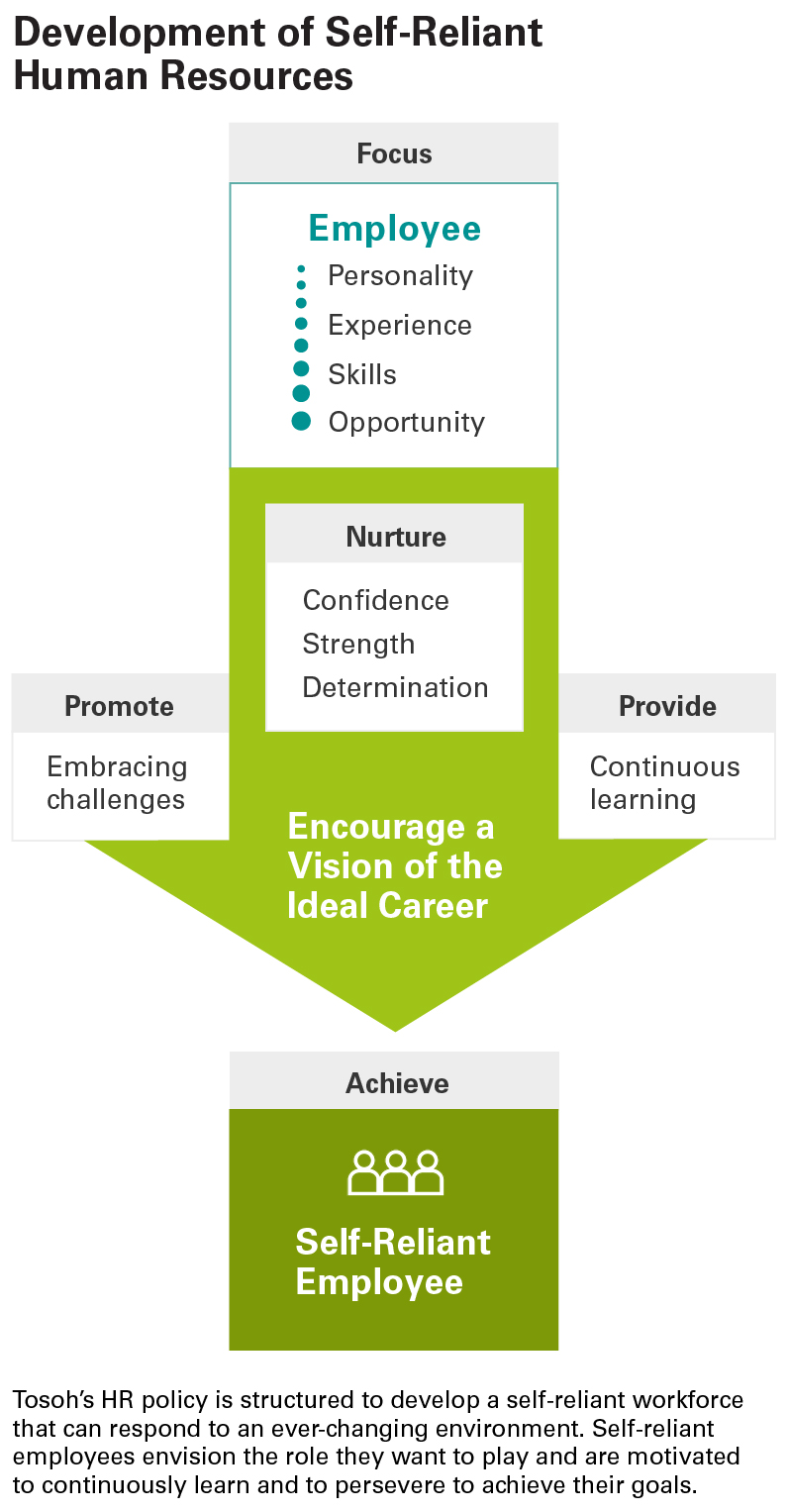
Structure and management
The Human Resources general manager is responsible for the development and implementation of the education system and basic policies. The Education and Training Council—consisting of the head of the Human Resources department and the leaders of specialized departments responsible for implementing highly specialized training—supervises, promotes, and evaluates training content throughout the company. Moreover, the plan–do–check–act (PDCA)cycle is implemented by reporting and discussing the content of education conducted at each complex and reflecting the results in future content.
Each manufacturing complex conducts an annual Education and Training Council meeting based on the education and training conference to oversee, promote, and evaluate the education and training of the complex. Each department manager and supervisor formulates and implements training plans for their own department, and monitors and checks the status of training, in order to improve personal qualities and utilize available knowledge and skills in their work.
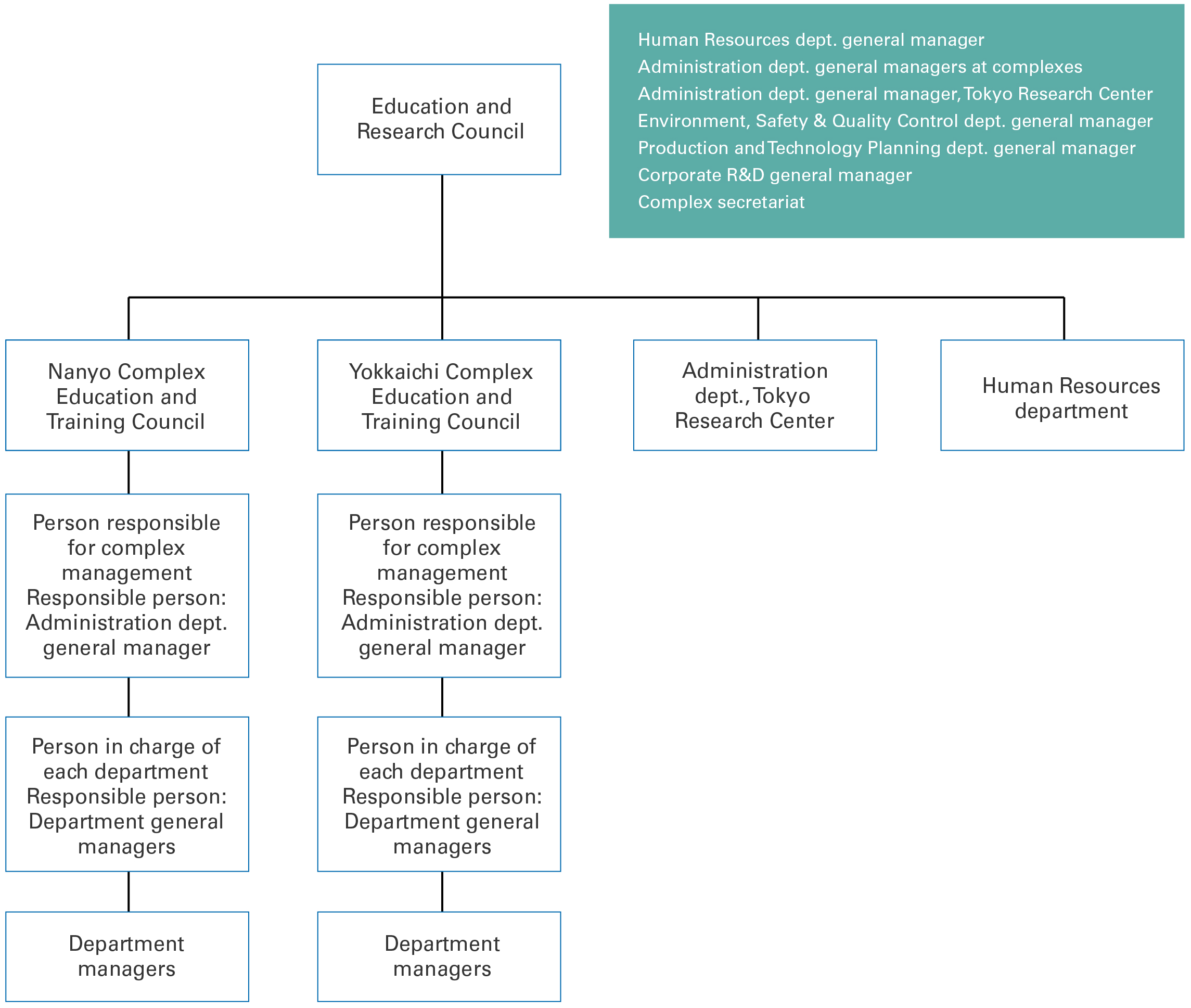
Career education system for self-reliant human resources
Self-reliant human resources are defined as people who can create their own tasks and roles and involve others to achieve results in any environment, whether inside or outside the organization.
Tosoh restructured its training system from a traditional focus on imparting skills to a sustainable learning program based on career education. Under the new program, we aim to develop self-reliant human resources through sustained learning in four areas: basic education (regulations and laws), acquisition of skills through self-development, learning through work experience and opportunities, and global human resources development. The company has clarified the five elements necessary to achieve this, and designed an educational program that enables each element to be achieved in a step-by-step manner.
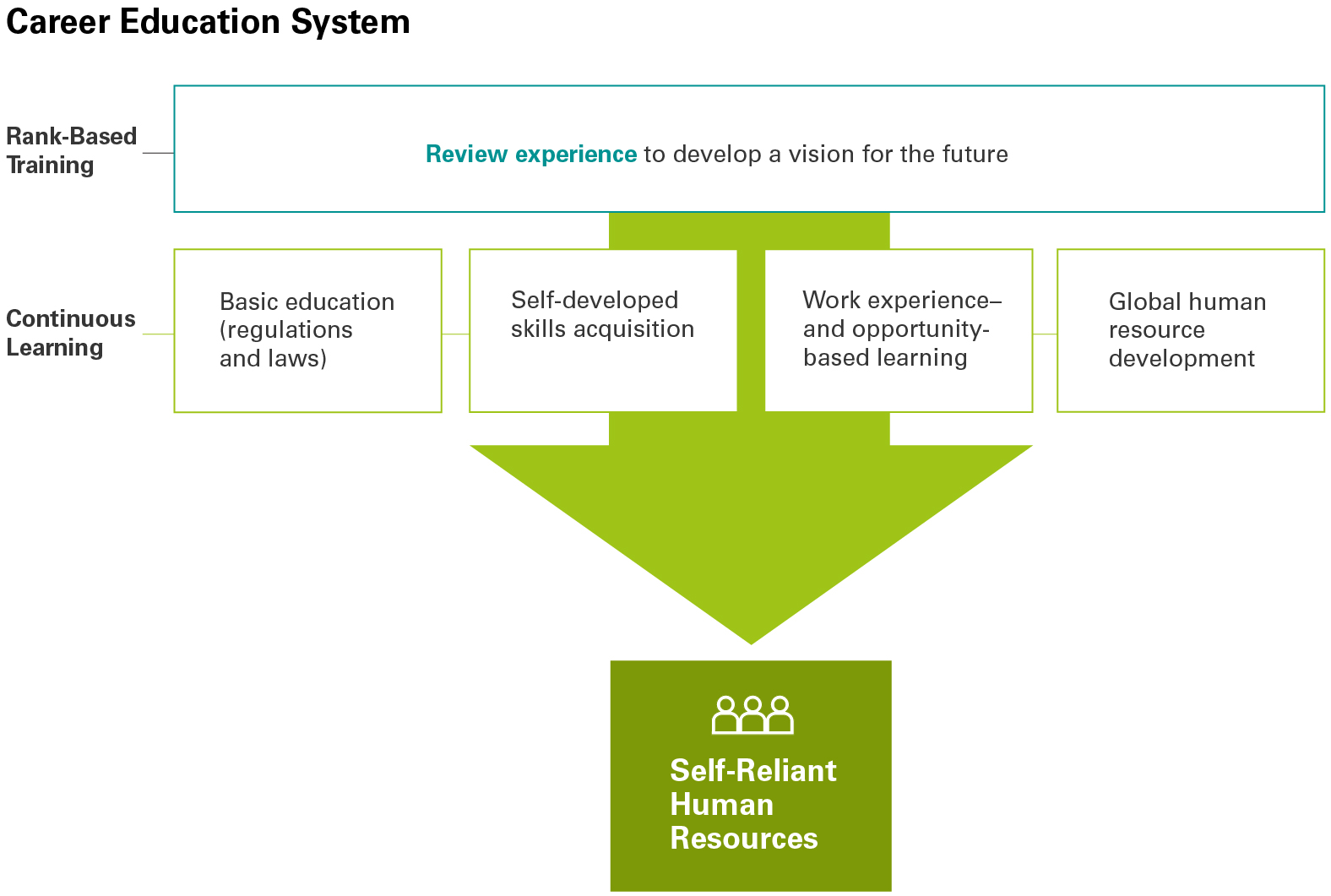
Five elements necessary for Tosoh's self-reliant human resources
| Required elements |
Interpretation |
| Ability to involve and motivate others |
Rather than just accepting others’ current involvement, recognize those with values different from yours and take the initiative to motivate them. |
| Ability to continually change oneself |
Rather than accepting the status quo, look for what can change, formulate strategies, and actively influence behavior. |
| Determination to finish what one starts |
Find alternatives even when facing challenges, believe the future can be better, and persist in achieving targets without giving up. |
| Ability to imagine and create |
Look beyond merely solving the apparent problems, defining larger issues by imagining targets and the ideal outcome before seeking solutions. |
| Spirit of inquiry |
Maintain an interest in a wide range of topics, creating innovations through combinations from disparate areas. |
Career education
In this era of volatility, uncertainty, complexity, and ambiguity, to respond to changes in the environment it is necessary for employees to envision what they want to be, and to maintain a willingness to learn and work toward achieving that vision. We promote employee-led career development, by which employees consider what skills they need to develop for their jobs, encouraging all employees to generate significant added value and fuel Tosoh's competitiveness.
Career education is introduced in the rank-based training programs to take stock of one's career to date and to envision what one wants to be in the future. After having taken stock of their career to date and envisioning their future career path, all trainees have the opportunity to attend career counseling sessions with consultants. Through this approach, we clarify career goals, raise awareness of work targets, improve job satisfaction, and encourage personal growth. We are working to achieve a career counseling uptake of 70 percent or more among career-track employees by fiscal 2025.
Furthermore, we established a new Career Support Group in fiscal 2023 to provide an environment for all employees to discuss their careers with a nationally certified career consultant. We support our employees in thinking about their ideal careers and lifestyles, so they can flourish in various work styles, aptitudes, and circumstances. In addition to needing to be aware of their own roles and careers, executives also have the important responsibility of offering career support to their subordinates and junior staff, and Tosoh’s training for executives therefore incorporates this aspect.
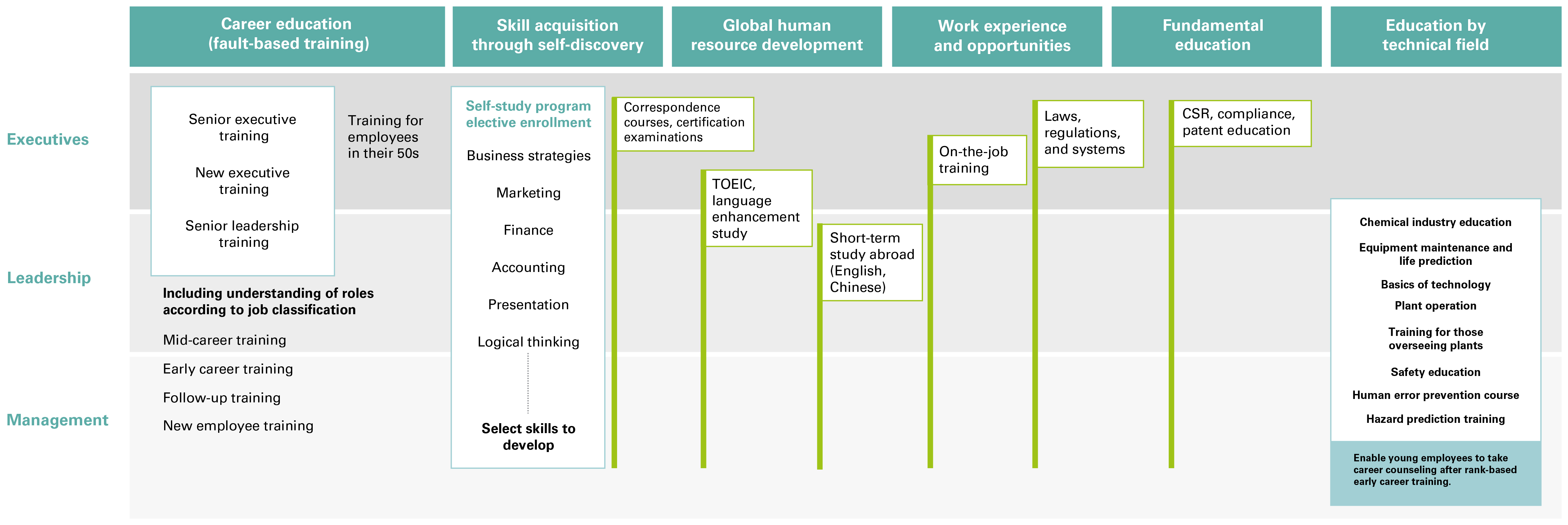
Career-track employee training by rank in fiscal 2023 (non-consolidated)
| Training |
Target |
Purpose of training |
Main content of training |
Training time per employee (hours) |
No. of participants |
New employee
training |
New employees |
Solidify attitude toward work |
- Overview of the entire company (human resource sys
- tem, R&D, compliance, CSR, human rights, etc.)
- Explanation of each complex, division, and group company
- Groupwork (Theme: Tosoh's businesses, what is expected of new employees, etc.)
- Stance training (learning how to handle work as a member of society)
- Career training (Reflect on past experiences and identify sources of motivation; reflect on the experiences in which the most effort has been exerted; deepen and share ideas about what each employee hopes to gain from working; establish future "ideal vision" and clarify the actions they should take after attending the training)
|
187.5 |
87
(Male: 61, Female: 26) |
| Follow-up training |
Year 2 with company |
Provide opportunity for self-reflection and enlightenment through group discussions |
- Presentations within the assigned work groups
- Group discussion (Objectives: understanding personality traits and perspectives on being independent, practicing techniques to be more independent) (Theme: changing perspectives and giving advice on what can and cannot be changed/situations that lower motivation)
- Lectures and exercises (Aimed at employees who can think, judge and act independently)
|
12 |
111
(Male: 94, Female: 17) |
| Early career training |
Years 3-4 with company |
Clarify career direction |
- Career training (Self-understanding as a basis for job crafting, selection of target tasks for job crafting/ experiential learning, and planning for promotion of experiential learning)
- Career consulting
|
7.5 |
117
(Male: 94, Female: 24) |
| Mid-career training |
Equivalent to 7 years with the company |
Develop medium- to long-term career vision |
- Career training (Self-resources for autonomous career development, autonomous career development methods, and workplace-based realistic career development planning)
- Career consulting
- Compliance, harassment, CSR, human rights education
|
15 |
70
(Male: 65, Female: 5) |
Senior leadership
training |
Senior leadership positions |
Take inventory of career and understand role |
- Career training (Career review, clarify behavioral characteristics, consider senior leadership roles, set career vision, create action plan)
- Career consulting
|
12 |
40
(Male: 36, Female: 4) |
New executive
training |
Newly appointed executives |
Take inventory of career and understand role as an entry-level executive |
- Career training (Career review, role of first-time executive employee, ideal vision, and action plans)
- Career consulting
- Compliance, harassment, CSR, human rights education
|
22.5 |
59
(Male: 58, Female: 1) |
Senior executive
training |
Senior executive
positions |
Reaffirm one's role and responsibilities as senior executive |
Management improvement, compliance, internal control, management |
15 |
39
(Male: 39, Female: 0) |
Investment Amount in Education and Training (non-consolidated)
|
Fiscal 2021 |
Fiscal 2022 |
Fiscal 2023 |
| Investments (millions of yen) |
30.1 |
38.1 |
55.7 |
Support for independent learning
Tosoh has established a correspondence education system to aid employees in acquiring the basic knowledge and general education and skills required for their work, and to support their independent learning. Participants can take courses regardless of their own work duties. Fifty to eighty percent of the course fee is subsidized for those who complete such programs. The company pays for all courses taken during childcare leave, used as self-development during leave and as preparation for returning to the workplace.
Employees taking correspondence courses (non-consolidated)
|
Fiscal 2021 |
Fiscal 2022 |
Fiscal 2023 |
| Attendees |
260 |
374 |
267 |
Encouraging certification acquisition and skill testing
Tosoh supports its employees in taking examinations and courses to obtain various certifications and licenses. Employees who obtain qualifications and licenses designated by Tosoh are publicized in internal newsletters, and receive rewards divided into five categories according to the degree of difficulty. To improve the technical skills of general employees in the manufacturing and facilities management divisions, we have set the qualifications required for promotion to all positions.
Number of certification incentive payments (non-consolidated)
|
Fiscal 2021 |
Fiscal 2022 |
Fiscal 2023 |
| Benefits provided |
625 |
445 |
739 |
Global human resources development
Tosoh's overseas sales account for more than 50 percent of its total sales. The company expects further opportunities for involvement with overseas markets in the future, regardless of business or job classification. Reflecting this, in fiscal 2023 we have reviewed our global human resources development program. Tosoh defines global human resources as people who can use language as a tool to advance their work and expand Tosoh's business internationally. The company aims to raise the language capabilities of employees by providing support programs according to language level. In the future, we plan to raise the language ability level within the company and expand the programs we offer for learning about local business practices through overseas training. We will bolster our development of global human resources by expanding our programs to enable employees to increase their global knowledge and acquire the ability to grow our global business further.
New graduate and mid-career recruitment
In the interest of realizing sustainable growth, Tosoh is striving to secure the appropriate personnel, who have diverse values and can function effectively on the global stage. In hiring new graduates, the company seeks individuals with an inquiring and pioneering spirit, who are willing to work tirelessly to learn about things in depth, and who are adept at problem-solving with a diverse group of colleagues. To this end, through its recruitment website and pamphlets, the company provides information on its priority areas, technological trends, and human aspects.
Furthermore, Tosoh contacts students at an early stage through industry research seminars and one-day work experience programs. The objectives are to promote not only its corporate philosophy and management policies but also its corporate culture, through its senior employees. In fiscal 2024, Tosoh hired 99 people for career-track positions and 86 for general positions.
For mid-career hires, the company aims to secure personnel with expertise and experience to make an immediate impact in important areas of research and technology development.
Initiatives to ensure appropriate employee allocation
It is necessary to allocate employees according to their aptitudes and desire to invigorate the entire organization. To this end, Tosoh is building a talent management system that brings together the variety of employees needed for appropriate placement, and centrally manages the data. Tosoh employees register their specific work histories and knowledge in the system, and this information is managed and shared with the Human Resources department, other employees, and their supervisors. The company also intends to introduce an internal recruitment system, for transfers that reflect the will of employees. By promoting these measures, Tosoh will achieve appropriate allocations of employees to maximize their abilities more than ever.